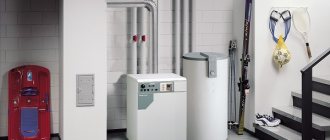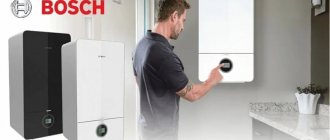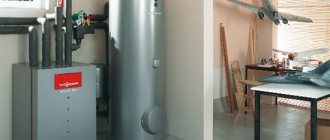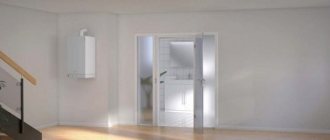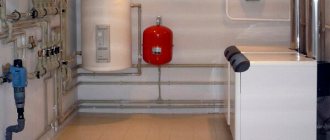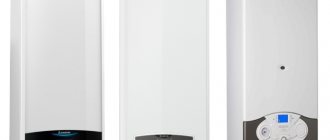Choosing a boiler for a heating system is an important and responsible procedure that determines the microclimate of the house for the coming years.
Errors in this matter are unacceptable, but most users do not have sufficient knowledge on this topic.
You need to clearly understand the design features of gas boilers and be able to determine the most successful parameters and set of functions.
Sales consultants often try to sell stale goods and give distorted information, so it is useful to have some information about the most important aspects.
Let's consider one of the most effective and popular groups of heating gas boilers - floor-standing models
On smartphones, you can scroll the table right/left ↔
| Place | Name | Price |
| TOP 10 best floor-standing gas boilers for heating | ||
| 1 | Protherm Wolf 16 KSO | Find out the price |
| 2 | Lemax Premium-12.5 | Find out the price |
| 3 | Lemax Premium-20 | Find out the price |
| 4 | BAXI SLIM 1.230 iN | Find out the price |
| 5 | Lemax Premium-25N | Find out the price |
| 6 | Siberia 11 | Find out the price |
| 7 | MORA-TOP SA 20 | Find out the price |
| 8 | Lemax Premium-10 | Find out the price |
| 9 | Lemax Premium-16 | Find out the price |
| 10 | Lemax Clever 30 | Find out the price |
Single-circuit and double-circuit floor-standing boilers
The basic function of any boiler is to heat the coolant for the heating circuit. All models have it, regardless of what additional capabilities they have .
There are units designed only for the preparation of coolant. These are single-circuit boilers that perform a single, main task. In addition, there are double-circuit boilers that can simultaneously prepare hot water for domestic needs while heating the heating agent.
They are equipped with an additional heat exchanger, which uses part of the excess thermal energy of the coolant.
These units are called dual-circuit. They allow you to get the maximum range of functions, but have some limitations in the performance of the DHW circuit.
Heating occurs in a flow mode, so it is not yet possible to achieve a uniform and stable temperature.
NOTE!
Single-circuit boilers can be connected to external storage boilers. This will require some expenses, but as a result it makes it possible to obtain a stable and even hot water supply.
The difference between floor and wall
The choice of one type or another depends on the room that will be heated.
- The power of floor-standing installations is enough even for a large house , but wall-mounted installations cannot boast of this;
- But they require a separate room to accommodate them;
- Also, installing such equipment will require much more labor;
- Among wall-mounted devices it is almost impossible to find one that is independent of electricity, while among floor-standing ones they predominate;
- Any carrier circulation system is suitable for use - forced or natural;
- A chimney is required;
- The cost of a floor-standing boiler is much higher than that of a wall-mounted counterpart.
Advantages
- Ease of use - there is no need to constantly monitor the operation of the unit;
- High efficiency;
- Possibility to heat a large house.
Flaws
- Before installation, you need to obtain many permissions from different authorities;
- for operation ;
- Placement is allowed only in a well-ventilated area;
- Requirements for the premises (area, distance from fire sources, free access to elements, etc.);
- Installation cost.
Advantages and disadvantages
The advantages of floor-standing boilers include:
- no restrictions on the power of the unit;
- strength, reliability of all components and parts;
- ease of installation;
- stability of operation, the ability to maintain a given mode regardless of external conditions;
- no unnecessary additions;
- powerful models can be connected in a cascade of up to 4 units, forming high-performance thermal units.
The disadvantages of floor structures are:
- large weight, size;
- the need for a separate room;
- for atmospheric models it is necessary to connect to a common house chimney
IMPORTANT!
In addition to a separate room, for floor-standing boilers it is necessary to ensure the possibility of connecting to a vertical chimney or leading a horizontal pipe through the wall.
Heating system power
Before choosing a specific equipment model, it is necessary to determine the required power of a gas floor-standing boiler. Often, calculations are based on the formula of 1 kW of power per 10 m2 of area of a private house. At the same time, for individual regions the correction factor should also be taken into account.
If you decide to opt for double-circuit equipment, then you should add another 25% to the calculated value, which will be responsible for hot water supply.
Depending on the ability to adjust the boiler power, not only the efficiency of the heating device will be determined, but also its reliability. There is one- and two-stage power adjustment.
To ensure economical operation of the device, preference should be given to a modulating burner; in this case, fuel is consumed slowly.
To quickly determine the required boiler power, you can use a convenient plate with calculated data.
| House area, m2 | Boiler power, kW |
| 60-200 | up to 25 |
| 200-300 | 25-35 |
| 300-600 | 35-60 |
| 600-1200 | 60-100 |
Convection or condensation?
The traditional method of heat transfer from a gas boiler is heating the coolant in flow mode. It passes through a heat exchanger, and the gas burner heats the liquid according to the specified operating mode.
This type of boiler is called convection boiler. Relatively recently, a new design of units appeared - condensing. It uses preheating of the coolant from the heat released during condensation of the exhaust smoke.
The temperature of the liquid increases by a small amount, but this is enough to reduce the heating mode of the main heat exchanger.
As a result, a positive effect is achieved:
- fuel consumption is reduced;
- the load on the burner and heat exchanger is reduced;
- The service life of the boiler increases.
With properly organized operation of the unit, fuel savings reach 20%. However, there are some specific conditions that sharply limit the scope of application of condensing boilers.
The reason is that the condensation process can only occur when the temperature of the walls of the condensation chamber is higher than the return flow temperature. This is only possible on underfloor heating systems or radiator circuits with a low degree of heating.
It is calculated that the operation of the first stage is possible only if the difference between the outside and inside of the house is no more than 20°. For Russia, such a ratio is simply impossible. If condensation is not possible, the boiler operates as a conventional convection model.
Considering the almost twofold difference in prices, one should weigh the feasibility of such an expensive purchase with its dubious effectiveness.
What does profitability depend on?
An ideal gas heating boiler must first effectively burn main or liquefied gas, and then use all the resulting heat to heat the coolant for the heating system. In reality, not everything is so smooth, and here's why:
- To effectively burn fuel and obtain the maximum amount of heat, you need to mix gas and air in precise proportions (approximately 1: 10). Not every heat generator can do this.
- During the combustion reaction of methane, carbon dioxide and simple water are released, which immediately evaporates, taking away part of the thermal energy of the burned fuel.
- A priori, heated combustion products cannot transfer all the energy to the coolant; some of it will still fly out into the chimney. The size of this part depends on the design of the heating unit.
The efficiency of Atem non-volatile double-circuit boilers with an open combustion chamber ranges from 86...88%
. It turns out that one part of the energy contained in the fuel is lost at the combustion stage, and the other during heat transfer. The smaller these losses are, the more rationally fuel energy is used and the more economical the gas boiler for the home is. The efficiency of the heater is characterized by its efficiency specified in the technical data sheet for the product. The higher this indicator, the more heat the heat generator directs to heat the coolant and the more economical it uses natural gas.
The efficiency of modern gas boilers depends on their design and ranges from 85 to 96%. The higher efficiency figures announced by heating equipment sellers do not correspond to reality.
What is the difference between non-volatile and conventional boilers?
Conventional (volatile) boilers require an electrical supply, without which they cannot operate. The turbofan, circulation pump, and electronic control board require high-quality and stable power supply.
Particularly capricious are control boards, which immediately fail when the current parameters change. Manufacturers claim the ability to withstand large voltage fluctuations, but in practice this is not observed.
At the same time, volatile units have a set of additional capabilities - they can be controlled remotely, integrated into a smart home system, and programmed for some time in advance..
Non-volatile boilers do not have all these additions. They work exclusively with the help of mechanical components and parts, like a regular gas stove.
The design of such units is devoid of all unnecessary components, it is functional and therefore very reliable. In addition, owners of non-volatile boilers do not face the risk of being left without heating in the event of a sudden power outage.
Dilapidated and overloaded networks are a typical phenomenon for remote villages, so the use of independent heating systems is very valuable for many users.
Types of heat exchanger materials – what to choose?
The heat exchanger is the main component of a gas boiler. The coolant is heated in it, so the parameters and design of this unit are of great importance.
For production use:
- stainless steel . This is a budget option, although the parameters of steel heat exchangers allow you to get quite effective results. Typically, such units are installed on inexpensive medium-power boilers;
- copper tube (coil) . This option is used on expensive models of gas boilers. Copper has a high heat transfer coefficient, so the effect of using such heat exchangers is very high;
- cast iron. It is resistant to mechanical and thermal loads. For the manufacture of heat exchangers, gray ductile metal is used, which is resistant to changes or different values of liquid temperature at individual points. Massive units help equalize the degree of heating and soften sudden temperature changes.
Copper heat exchangers are considered the most preferable, but steel and cast iron units are also quite functional and can provide high-quality heating of the heating agent.
Condensing units
I would like to indicate the rating of condensing boilers. In today's market, their range is increasing. All manufacturers try not to miss the opportunity to prove that they remain in trend. But even the most famous companies do not always manage to create the best boiler. That's why you won't see many of them in our ranking.
De Dietrich Innovens PRO MCA
Oddly enough, the French take first place. The reasons are that their boilers are the best in terms of operating efficiency, safe operation requirements, productivity, and energy saving. The power of the units varies from 43 to 114 kW. All models belong to the “wall-mounted” category.
Design features:
- the heat exchanger is made of an alloy of aluminum and silicon, and it has a monoblock design;
- steel burner;
- composite body insulation;
- self-diagnosis system;
- full automation;
- condensate is collected in a special siphon;
- There is a backlight inside, which is very convenient when servicing the boiler;
- sensor showing the temperature of the exhaust gases;
- Efficiency 102.5%.
Wall-mounted condensing boilers from De Dietrich Source sanitech-instalacje.pl
Viessmann Vitodens 100-W
In the model line of this brand there are both single- and double-circuit heating devices with a power of 19-35 kW. An interesting fact is that in the category of gas-fired condensing boilers, these are the cheapest.
Design Features:
- heat exchanger made of stainless steel;
- the burner is steel, it is cylindrical in shape;
- the air is driven into the firebox by a fan, and if you correctly configure it in terms of rotation speed, you can save a lot on fuel consumption;
- the exhaust gases have a very low content of harmful substances;
- protective systems against freezing and overheating;
- convenient arrangement of parts and assemblies in the body;
- Efficiency 108%.
Gas boiler Viessmann Vitodens 100-W: appearance and inside Source www.v-store.ro
Vailliant ecoTEC plus VU OE
This manufacturer has only two models with a power of either 45 or 65 kW. Advantages: high environmental friendliness and cost-effectiveness. Both models are single-circuit, but it is possible to connect a boiler to them. Boilers can only be used in low-temperature heating systems. In Germany they are installed on the roofs of private houses.
Peculiarities:
- Efficiency – 109%, that is, the highest efficiency;
- burner adjustable in power within 28-100%;
- full automatic;
- circulation pump – two-stage with the possibility of manual or automatic switching;
- fan with adjustable rotation speed.
Types of boilers by type of smoke removal and which one is better?
There are two options for removing combustion products:
- atmospheric. This is a traditional way of removing flue gases using natural stove draft. The technique is well studied, but is unstable and highly dependent on external conditions. Most often used on non-volatile models;
- using a turbofan . The combustion chamber of such boilers is isolated from the outside atmosphere, so the combustion process and smoke removal are ensured by a turbocharging fan. It supplies fresh air, which supports the flame and displaces smoke into a specially designed chimney (coaxial).
Turbocharged boilers are considered more convenient designs for use in residential premises - there is no smell of smoke, oxygen does not burn out, the unit is completely safe.
However, such boilers need to be connected to the power supply.
Selection of coolant
Usually two options are used:
- water. Experts recommend using distilled water if the volume of the system allows it. This method avoids the formation of lime deposits, but it will not protect against freezing of pipes in winter;
- ethylene glycol (antifreeze) . This is a liquid that does not freeze when circulation stops. Contains a set of anti-corrosion additives, does not form scale, and does not have a destructive effect on polymers, rubber, and plastic.
For systems that need to be drained frequently, water is the best and most economical choice. The use of antifreeze is recommended for heating circuits that operate under difficult conditions.
Types of boiler ignition methods and which method is the most optimal?
There are three ignition options:
- electronic. The burner is ignited at the touch of a button using a special unit. This option is present on all models of volatile boilers;
- piezoelectric. The principle of operation of such a system is similar to all piezo devices - in order for a spark to appear, you need to press on a special crystal. Used on non-volatile boilers. Many users find this type of ignition inconvenient;
- manual. The flame is ignited with an ordinary lit match (spear). For ignition, you need to have a certain supply of such elongated wooden sticks.
Most users unanimously prefer the electronic type of ignition, but it is not possible on non-volatile units. You have to get used to using a piezoelectric element or ignite the burner with a burning torch.
Types by combustion chamber type
There are two types of combustion chambers:
- atmospheric (open) . They work on the traditional principle - air is taken directly from the surrounding atmosphere, and smoke is removed using natural draft. For the operation of such boilers, appropriate conditions are required, so they are not in great demand. However, atmospheric units are capable of operating in energy-independent mode;
- turbocharged (closed) . The fully sealed design requires air supply, which is done using a turbofan. This method allows you to regulate the combustion mode and the removal of combustion products. It is considered the most convenient and safe.
The choice of combustion chamber is determined by the design of the boiler - all non-volatile models are atmospheric, and dependent units can be either open or closed.
Turbocharged vehicles are preferred.
Main disadvantages
However, a gas heating boiler also has certain disadvantages. The main ones are the following:
- installation of floor-standing boilers is more complicated, in contrast to the wall-mounted counterpart;
- the need for installation in a special room;
- energy dependence;
- high cost of equipment for automatic boiler control;
- The kit does not include strapping elements.
In addition, despite the high safety of gas installations, their operation still needs to be monitored, since even minor interruptions disrupt the normal production cycle.
Rating of TOP 10 floor-standing gas boilers
Let's look at the features of some of the most popular models of floor-standing gas boilers:
Protherm Wolf 16 KSO
The company from Slovakia produces a wide range of gas boilers. The Volk 16 KSO model is a single-circuit boiler with a capacity of 16 kW. It can successfully heat a house of 160 square meters. m .
The boiler heat exchanger is two-pass, made of stainless steel.
Main settings:
- Efficiency - 92%;
- coolant temperature - 30-80°;
- system pressure - up to 1 bar;
- gas consumption - 2.1 m3/hour;
- dimensions - 390x745x460 mm;
- weight - 46.5 kg.
All series of Protherm boilers are named after various animals. By their appearance, you can determine whether a given model belongs to a specific equipment group.
Lemax Premium-12.5
Floor-standing single-circuit gas boiler made in Russia. With a power of 12.5 kW, it is capable of heating rooms up to 125 sq. m. m.
Main characteristics:
- Efficiency - 90%;
- coolant temperature - 90°;
- system pressure - up to 3 bar;
- gas consumption - 1.5 m3/hour;
- dimensions - 416x744x491 mm;
- weight - 55 kg.
Non-volatile units make it possible to increase operational reliability and relieve concerns about the safety of heating in the winter.
Lemax Premium-20
Russian floor heating boiler. The power of the unit is 20 kW, making it a good choice for owners of houses up to 200 sq.m.
A non-volatile boiler with a steel heat exchanger has the following parameters:
- Efficiency - 90%;
- coolant temperature - 90°;
- system pressure - up to 3 bar;
- gas consumption - 2.4 m3/hour;
- dimensions - 556x961x470 mm;
- weight - 78 kg.
Single-circuit non-volatile models have the simplest design possible, which increases the reliability and stability of their operation.
BAXI SLIM 1.230 iN
Italian engineers have developed a high-quality and productive model of a floor-standing gas boiler with a capacity of 22.1 kW. This allows the unit to heat an area of up to 220 square meters. m .
- Efficiency - 90.2%;
- coolant temperature - up to 85°;
- system pressure - up to 3 bar;
- gas consumption - 2.59 m3/hour;
- dimensions - 350x850x600 mm;
- weight - 103 kg.
BAXI boilers belong to the group of elite heating equipment and are one of the leaders in European heating technology.
Lemax Premium-25N
Another representative of domestic heating equipment, manufactured in Taganrog. This is a single-circuit, non-volatile gas boiler designed for floor mounting.
Its parameters:
- Efficiency - 90%;
- coolant temperature - 90°;
- system pressure - up to 3 bar;
- gas consumption - 3 m3/hour;
- dimensions - 470x961x556 mm;
- weight - 83 kg.
The warranty on Lemax boilers lasts 36 months, which increases the technical support of the manufacturer by one and a half times and allows the user to receive specialized repairs or maintenance of the units.
Siberia 11
Rostov products. The power of this floor-standing energy-independent unit is up to 11.6 kW , allowing you to heat a house up to 120 sq. m.
All controls are mechanical; a power outage will not affect the heating system in any way.
Boiler parameters:
- Efficiency - 90%;
- coolant temperature - 90°;
- system pressure - up to 3 bar;
- gas consumption - 1.18 m3/hour;
- dimensions - 280x850x560 mm;
- weight - 52 kg.
The company's arsenal includes single- and double-circuit models of boilers of this series.
MORA-TOP SA 20
Czech floor-standing boilers with a cast iron heat exchanger provide high reliability and stability of home heating. The MORA-TOP SA 20 model has a power of 15 kW and is designed for operation in rooms up to 150 sq. m. m.
Boiler characteristics:
- Efficiency - 92%;
- coolant temperature - 85°;
- system pressure - up to 3 bar;
- gas consumption - 1.6 m3/hour;
- dimensions - 365x845x525 mm;
- weight - 99 kg.
The heat exchanger design is sectional and consists of 3 compartments. The boiler is non-volatile, but is equipped with two types of pipes - for natural and forced circulation .
Lemax Premium-10
Floor-standing non-volatile gas boiler with a power of 10 kW. of heating a house up to 100 sq.m.
- Efficiency - 90%;
- coolant temperature - 90°;
- system pressure - up to 1 bar;
- gas consumption - 1.2 m3/hour;
- dimensions - 330x748x499 mm;
- weight - 48 kg.
The boiler is single-circuit, all controls work on a mechanical principle.
Lemax Premium-16
Floor-standing gas boiler, designed to service the heating system of a private house up to 160 sq. m.
Its power is 16 kW, other parameters:
- Efficiency - 90%;
- coolant temperature - 90°;
- system pressure - up to 3 bar;
- gas consumption - 1.9 m3/hour;
- dimensions - 416x744x491 mm;
- weight - 55 kg.
This model is one of the most popular on the market, since its power is optimal for most private homes.
Lemax Clever 30
Single-circuit floor-standing gas boiler. Its power is 30 kW, which allows you to heat 300 sq. m. usable area. The unit is volatile, has electronic control and a comprehensive protection system.
Characteristics:
- Efficiency - 90%;
- coolant temperature - 90°;
- system pressure - up to 2 bar;
- gas consumption - 1.75 m3/hour;
- dimensions - 470x961x556 mm;
- weight - 85 kg.
The power of the unit is excessive for one residential building, so owners often buy such boilers together and use them to operate in 2 systems.
Review of the best models in terms of price-quality ratio
Lemax Premium-30B 30 kW
The Premium series boiler is a Russian unit, powerful and reliable. In the first year of its release to the market, it received a lot
flattering reviews from customers.
The controls are electronic and intuitive, capable of heating a large living area. The unit itself is dual-circuit, compact, and takes up little space. The build quality is excellent. Heat exchanger material is steel coated with anti-corrosion enamel, fuel is natural gas (flow rate - 3.5 cubic meters per hour).
There is protection (gas control), a thermometer and overheating protection. Warranty period - 3 years. This model has proven itself well in 2021-2022.
Specifications:
- Maximum thermal power: 30 kW;
- Heated area: 300 sq.m;
- Efficiency: 90%;
- Weight: 88 kg;
- Dimensions: 556x961x470 mm.
pros
- easy to buy spare parts for repairs;
- powerful;
- economical;
- no problem with cheap fuel.
Minuses
- makes noise during operation.
Lemax Premium-30N 30 kW
Single-circuit boiler with good power, packed in a steel box (steel thickness - 2 mm).
No electrical connection required. Burner - micro-flare injection POLIDORO, Italian automatics. Anti-corrosion enamel can withstand temperatures up to 950°C and does not deteriorate even under aggressive environmental influences.
The temperature regulator is fixed on the front panel of the boiler. The top panel can be easily removed. There is a gas control function. Warranty - 3 years.
Specifications:
- Maximum thermal power: 30 kW;
- The approximate area of the heated room is 300 sq.m;
- Efficiency: 90%;
- Weight: 77 kg;
- Dimensions: 556x961x470 mm.
pros
- low gas consumption;
- there is enough power to spare;
- you can choose a comfortable thermal mode yourself;
- affordable;
- pleasant appearance;
- easy setup.
Minuses
- There is no protection against overheating and freezing.
BAXI SLIM 1.150 i 14.9 kW
Single-circuit floor-standing unit with average efficiency and good protective functions: gas control, air vent
, safety valve. There is frost protection, flame modulation, automatic ignition and underfloor heating.
There is a display on the front panel. The heat exchanger is made of cast iron. The combustion chamber is open. An indirect heating boiler with additional piping can be connected to the boiler.
The warranty period is 24 months. The fuel can be either natural or liquefied gas.
Specifications:
- Dimensions: 350x850x520 mm;
- Thermal power: 8.50 - 14.90 kW;
- Weight: 93 kg.
pros
- electronic control;
- reliable;
- economical;
- pressure gauge;
- pump blocking protection.
Minuses
- high price.

